Introduction to the Complete Beginner’s Guide to Balcony Gardening
Living in a city doesn’t mean giving up on your dream of growing fresh herbs, vegetables, and flowers. Even without a backyard, your balcony can transform into a lush, green retreat — a personal sanctuary filled with life, color, and the quiet joy of nurturing plants.
Balcony gardening isn’t just about aesthetics; it’s about reconnecting with nature in a space that’s truly your own. Whether you have a compact apartment patio or a narrow ledge, there’s always room to grow something meaningful. From fresh basil by the kitchen door to trailing flowers that attract butterflies, your balcony can become both beautiful and productive.
In this guide, we’ll walk through how to start your very first balcony garden — step by step. You’ll learn how to choose the right containers, pick the best plants for limited sunlight, and set up a system that keeps your garden thriving all year round.
By the end, you’ll not only know how to create a green space that fits your lifestyle, but you’ll also understand how even a few pots of greenery can bring calm, color, and purpose to everyday city living.
Why Balcony Gardening is the Perfect Start
Balcony gardening isn’t just about growing plants — it’s about reclaiming a bit of nature in your everyday life.
Even a small balcony can become a sanctuary of green, color, and calm. Whether you’re growing herbs for your kitchen or adding flowers to brighten your mornings, balcony gardening brings life back to your living space.
It’s the perfect entry point for beginners because it’s easy to manage, requires minimal tools, and delivers visible results fast.
In this Complete Beginner’s Guide to Balcony Gardening, we’ll explore how to create your own green oasis, tailored to your personal taste and space.
Day 1: Plan Your Balcony Garden Space
Before buying a single seed, spend some time studying your balcony.
Notice how sunlight moves throughout the day, where shadows fall, and which corners feel breezy or calm.
Planning Checklist
- At least 4–6 hours of sunlight daily for herbs and vegetables.
- Shaded corners are ideal for ferns or mint.
- Ensure your balcony railings can handle the weight of planters.
- Keep a nearby water source or use a watering can with a long spout.
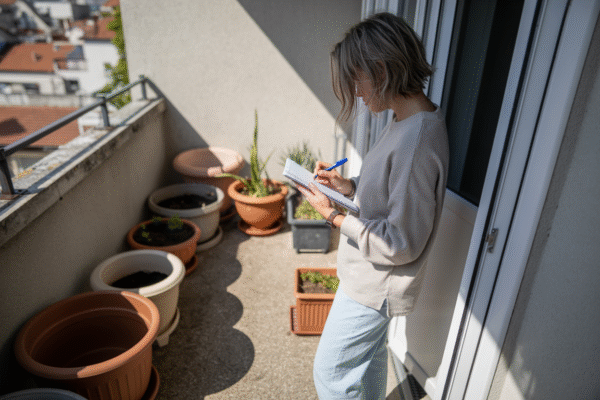
“Need inspiration for arranging your setup? Explore our balcony garden layout ideas for small apartments for smart space-saving designs.”
Tip:
If your balcony is mostly shaded, focus on low-light plants such as peace lilies, ferns, or mint.
Day 2: Choose the Right Containers
The right pot makes a huge difference in your plant’s health.
For balcony gardens, focus on lightweight containers that drain well and don’t overheat.
Recommended Containers
| Type | Benefits |
| Terracotta Pots | Breathable, natural, and ideal for herbs. |
| Plastic Planters | Retain moisture, easy to move around. |
| Hanging Baskets | Great for trailing plants or small flowers. |
| Vertical Shelves | Perfect for maximizing small spaces. |
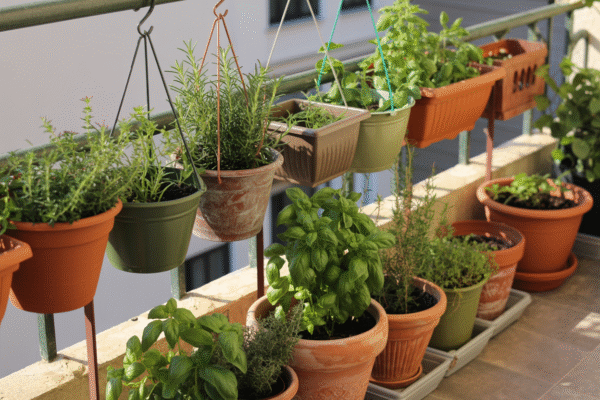
Pro Tip:
Avoid metal pots if your balcony gets strong sun — they trap heat and dry out soil quickly.
Day 3: Pick Easy-to-Grow Plants for Beginners
Choose resilient, low-maintenance plants that thrive with minimal care.
Best Beginner Plants
| Category | Examples |
| Herbs | Basil, Mint, Parsley, Chives |
| Flowers | Marigold, Petunia, Nasturtium |
| Vegetables | Cherry Tomatoes, Spinach, Lettuce |
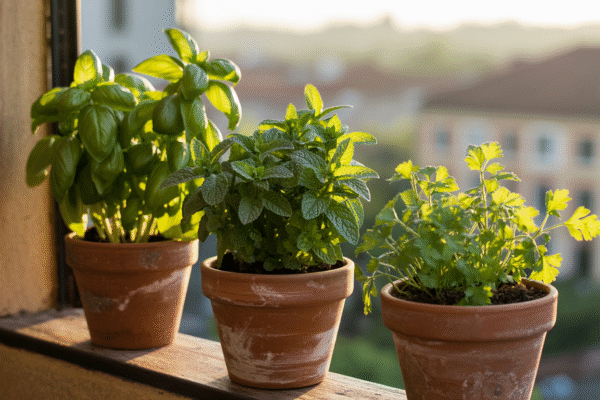
These plants grow fast, stay compact, and offer visual and sensory rewards — perfect for building momentum.
For more options, see our guide on 10 easy vegetables you can grow in containers — even without a garden
Day 4: Prepare Your Soil Mix
Your soil is the foundation of your balcony garden.
Regular garden soil is too heavy and compact — you need a mix that’s light, rich, and breathable.
DIY Potting Mix
- 40% coco peat or peat moss (for moisture retention)
- 30% compost (for nutrients)
- 20% perlite or coarse sand (for aeration)
- 10% vermicompost (optional for extra boost)
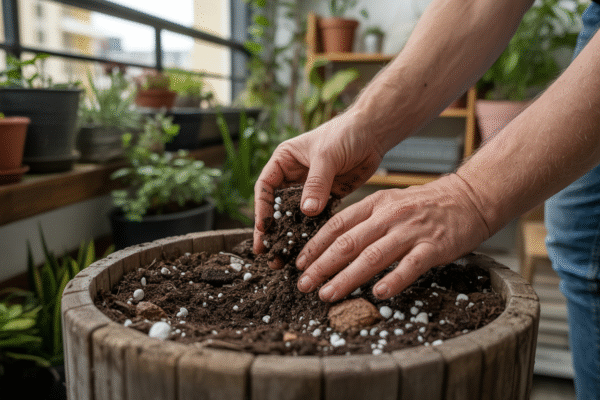
Mix thoroughly before filling your pots.
If your space is windy, consider adding a top layer of mulch to reduce evaporation.
Day 5: Plant and Water Smartly
Once your containers are ready, plant your seeds or seedlings early in the morning or late evening.
Avoid midday planting — the heat can shock tender roots.
Watering Tips
- Water slowly until moisture reaches the roots.
- Empty saucers after watering to avoid root rot.
- Mist leaves in the morning during hot seasons.
- Add mulch (like dry leaves) to retain moisture.
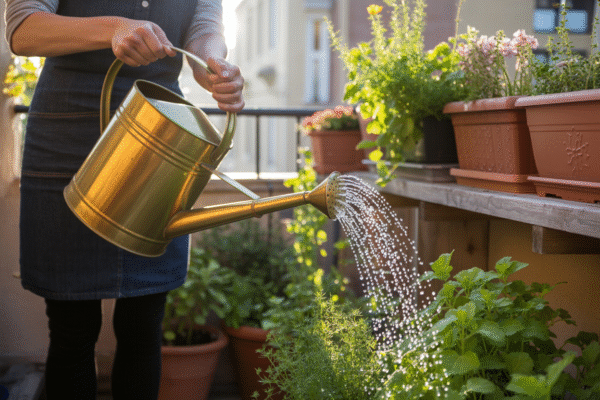
“If you travel often or have a hectic schedule, don’t worry — we’ve created a full guide on how to keep your balcony plants healthy when you’re busy or traveling.”
Expert Tip:
If you’re short on time, install a simple drip irrigation system with plastic bottles — easy, affordable, and efficient.
Day 6: Give Your Plants Light and Love
Now that your plants are settled, it’s time to help them thrive.
Light and Growth Tips
- Rotate pots weekly to ensure even sunlight.
- Cluster plants together to reduce wind exposure.
- Use reflective walls or mirrors to bounce extra light.
- Gently prune yellowing leaves — it encourages new growth.
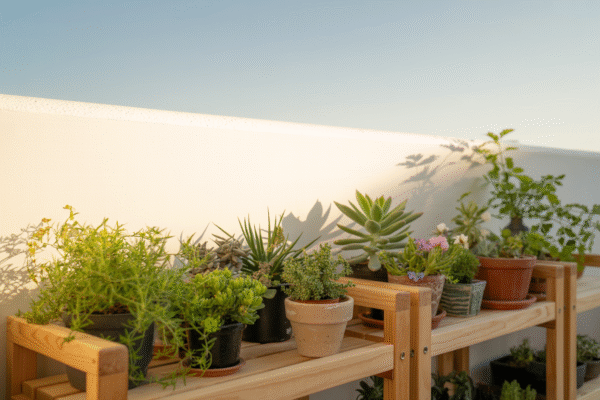
Day 7: Maintain and Enjoy
By now, your balcony is alive — small leaves, green shoots, and the scent of fresh soil.
Weekly Maintenance Routine
- Remove dead leaves and weeds.
- Check soil moisture every morning.
- Feed plants every 2–3 weeks with organic fertilizer.
- Observe — noticing small changes builds your gardening instincts.
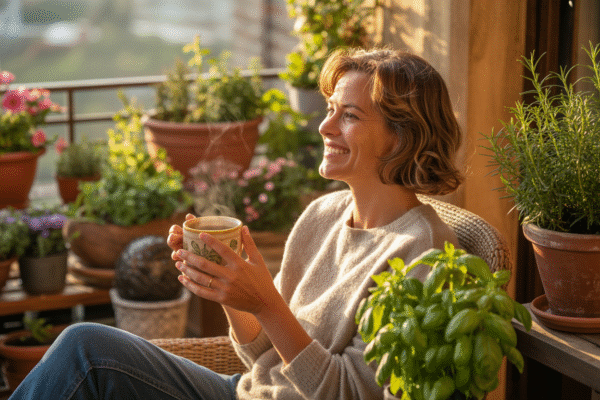
Mindful Tip:
Spend 5 minutes daily with your plants. You’ll be surprised how quickly it becomes the calmest part of your day.
Final Thoughts
Balcony gardening isn’t about perfection — it’s about presence.
Within a week, you’ll not only see growth but feel more grounded and connected.
Start small. Nurture what you plant. And remember — every balcony has the potential to become a little paradise.
FAQ
- What are the easiest plants to grow on a balcony for beginners?
Herbs like basil, mint, and parsley are perfect starters because they’re forgiving and thrive in small pots. You’ll also succeed easily with lettuce, spinach, and hardy flowers like geraniums or marigolds. - How much sunlight do balcony plants need?
Most edible plants need at least 4–6 hours of sunlight daily. If your balcony is shaded, choose low-light plants such as ferns, peace lilies, or begonias. - Can I garden on a north-facing balcony?
Yes — you can grow shade-tolerant herbs like mint, chives, and parsley, plus leafy greens. Focus on plants that prefer indirect light. - What’s the best soil for balcony containers?
Use a lightweight potting mix designed for containers — never regular garden soil. It holds moisture without compacting roots. - How do I prevent balcony plants from drying out too quickly?
Group pots closely to retain humidity, mulch the soil with bark or coconut coir, and consider self-watering planters to maintain consistent moisture.
For help with setting up your container layout, see our post on Balcony Garden Layout Ideas for Small Spaces
.

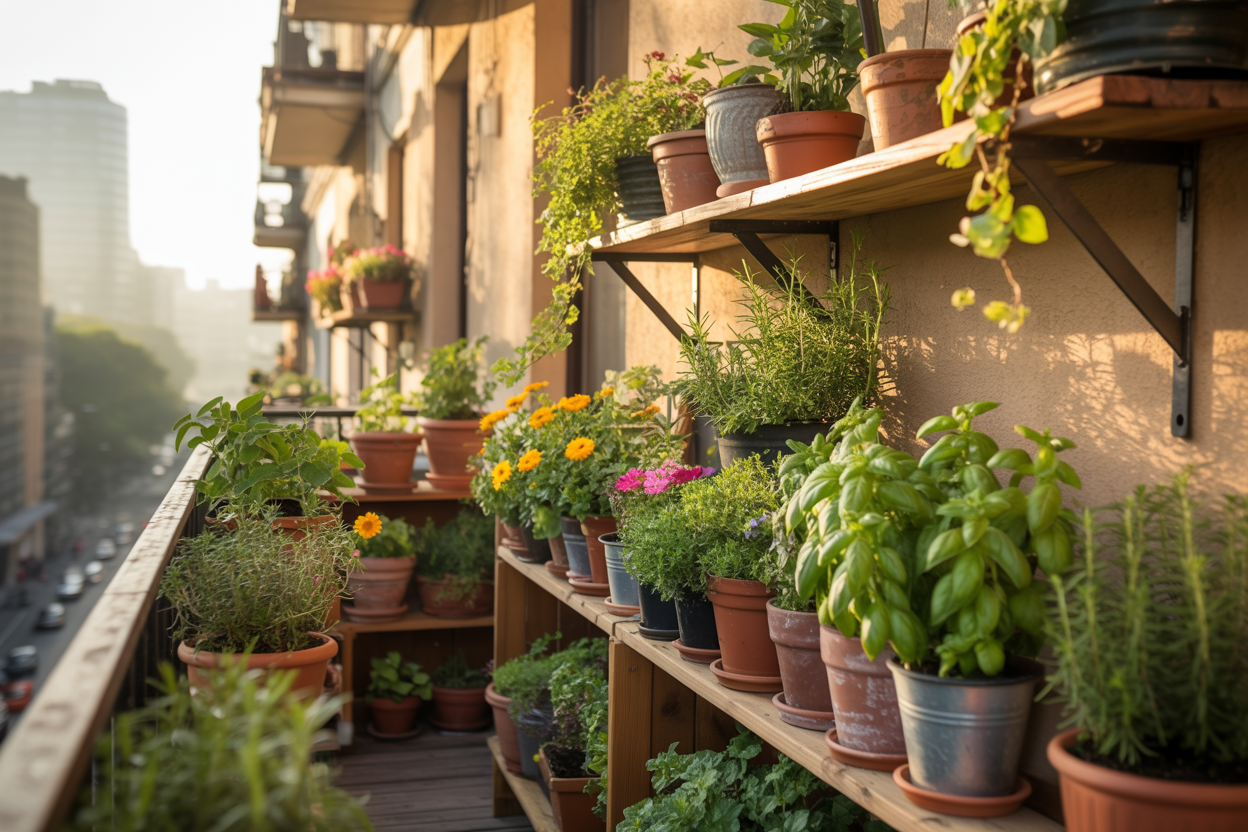
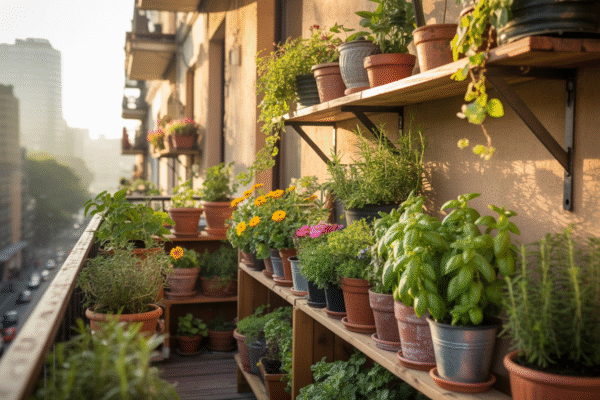
Beautifully written. I like the warm layout of the blog.